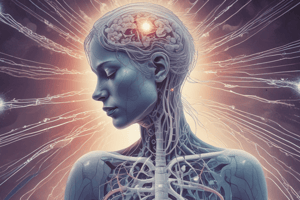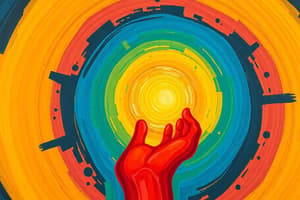Podcast
Questions and Answers
Pain perception is influenced solely by biological factors.
Pain perception is influenced solely by biological factors.
False (B)
GCT provides a good understanding of the complexities of pain.
GCT provides a good understanding of the complexities of pain.
True (A)
Pain assessment tools are based solely on clinical observations.
Pain assessment tools are based solely on clinical observations.
False (B)
Multidisciplinary perspectives are important in managing chronic pain.
Multidisciplinary perspectives are important in managing chronic pain.
Education on pain psychology is not included in chronic pain management programs.
Education on pain psychology is not included in chronic pain management programs.
The modern aim of pain management includes increasing drug reliance.
The modern aim of pain management includes increasing drug reliance.
Psychological interventions for acute pain management are considered second-level methods.
Psychological interventions for acute pain management are considered second-level methods.
Chronic pain causes are generally simple and one-dimensional.
Chronic pain causes are generally simple and one-dimensional.
Patient-controlled analgesia (PCA) is an example of increasing patient control in pain management.
Patient-controlled analgesia (PCA) is an example of increasing patient control in pain management.
The 'five D's' in chronic pain management include drama, disuse, drug misuse, dependency on others, and satisfaction.
The 'five D's' in chronic pain management include drama, disuse, drug misuse, dependency on others, and satisfaction.
C polymodal fibres are responsible for mediating chronic throbbing pain.
C polymodal fibres are responsible for mediating chronic throbbing pain.
A beta fibres are present in the diagram related to pain transmission.
A beta fibres are present in the diagram related to pain transmission.
Anxiety and depression can decrease pain tolerance.
Anxiety and depression can decrease pain tolerance.
Focusing on pain decreases the experience of pain.
Focusing on pain decreases the experience of pain.
Expectations of pain relief can create a placebo effect.
Expectations of pain relief can create a placebo effect.
The gate control theory of pain suggests that emotional experiences do not affect pain perception.
The gate control theory of pain suggests that emotional experiences do not affect pain perception.
Cognition includes beliefs about the ability to tolerate pain.
Cognition includes beliefs about the ability to tolerate pain.
Transmission of pain information only involves peripheral pain receptors.
Transmission of pain information only involves peripheral pain receptors.
Pain is defined as a pleasant sensory and emotional experience.
Pain is defined as a pleasant sensory and emotional experience.
The gate-control theory of pain is one of the psychological approaches to managing pain.
The gate-control theory of pain is one of the psychological approaches to managing pain.
Approximately 80% of all doctor consultations in the US relate to pain.
Approximately 80% of all doctor consultations in the US relate to pain.
Pain management programmes (PMPs) involve only doctors and nurses.
Pain management programmes (PMPs) involve only doctors and nurses.
Cognitive strategies in pain management focus on altering beliefs about unmanageability of pain.
Cognitive strategies in pain management focus on altering beliefs about unmanageability of pain.
Injury always guarantees the presence of pain.
Injury always guarantees the presence of pain.
Phantom limb pain occurs after healing of an injury.
Phantom limb pain occurs after healing of an injury.
Reinforcement of adaptive behaviours is a key component of behavioural strategies in pain management.
Reinforcement of adaptive behaviours is a key component of behavioural strategies in pain management.
According to Peter Gøtzsche, prescription drugs are the leading cause of death.
According to Peter Gøtzsche, prescription drugs are the leading cause of death.
Providing analgesic medication based on pain behaviours is a common approach in pain management.
Providing analgesic medication based on pain behaviours is a common approach in pain management.
Withdrawing attention from pain behaviours is a part of contingency management.
Withdrawing attention from pain behaviours is a part of contingency management.
Pain is solely a biological experience.
Pain is solely a biological experience.
Approximately 20% of the adult European population is affected by pain.
Approximately 20% of the adult European population is affected by pain.
Gate-control theory suggests that pain can be influenced by multiple factors.
Gate-control theory suggests that pain can be influenced by multiple factors.
Inactivity and poor physical fitness tend to close the pain gate.
Inactivity and poor physical fitness tend to close the pain gate.
Appropriate medication is a factor that can open the pain gate.
Appropriate medication is a factor that can open the pain gate.
Emotional factors such as anxiety and depression can contribute to opening the pain gate.
Emotional factors such as anxiety and depression can contribute to opening the pain gate.
The statement 'Pain is what the patient says it is' highlights the subjective nature of pain assessment.
The statement 'Pain is what the patient says it is' highlights the subjective nature of pain assessment.
Laughter and humor can help close the pain gate.
Laughter and humor can help close the pain gate.
The focus on pain tends to close the pain gate.
The focus on pain tends to close the pain gate.
Distraction is a cognitive factor that can close the pain gate.
Distraction is a cognitive factor that can close the pain gate.
Chronic pain management requires a multidisciplinary perspective.
Chronic pain management requires a multidisciplinary perspective.
Pain perception is influenced exclusively by biological factors.
Pain perception is influenced exclusively by biological factors.
Pain assessment tools rely on the clinician's observations alone.
Pain assessment tools rely on the clinician's observations alone.
Education on pain psychology is an important component of chronic pain management.
Education on pain psychology is an important component of chronic pain management.
Relapse prevention is not part of patient education in chronic pain management.
Relapse prevention is not part of patient education in chronic pain management.
C polymodal fibres mediate chronic throbbing pain.
C polymodal fibres mediate chronic throbbing pain.
Cognition does not include beliefs about the ability to control pain.
Cognition does not include beliefs about the ability to control pain.
The gate control theory of pain emphasizes the role of emotional experiences in pain perception.
The gate control theory of pain emphasizes the role of emotional experiences in pain perception.
Focusing on pain tends to increase the experience of pain.
Focusing on pain tends to increase the experience of pain.
Peripheral pain receptors do not transmit information to the brain.
Peripheral pain receptors do not transmit information to the brain.
Pain management programmes (PMPs) are only designed for doctors and nurses.
Pain management programmes (PMPs) are only designed for doctors and nurses.
Cognitive strategies in pain management aim to help patients alter their beliefs about the unmanageability of pain.
Cognitive strategies in pain management aim to help patients alter their beliefs about the unmanageability of pain.
Withdrawal of attention from pain behaviours is not considered a part of contingency management.
Withdrawal of attention from pain behaviours is not considered a part of contingency management.
Providing analgesic medication at set times is a common approach in pain management.
Providing analgesic medication at set times is a common approach in pain management.
Distraction and re-directing attention are techniques used to reduce anxiety in pain management.
Distraction and re-directing attention are techniques used to reduce anxiety in pain management.
The definition of pain includes an emotional experience associated with potential tissue damage.
The definition of pain includes an emotional experience associated with potential tissue damage.
Phantom limb pain occurs only during the healing process.
Phantom limb pain occurs only during the healing process.
Cognitive strategies in pain management ignore beliefs about pain.
Cognitive strategies in pain management ignore beliefs about pain.
The gate-control theory suggests that emotional experiences can influence pain perception.
The gate-control theory suggests that emotional experiences can influence pain perception.
Pain assessment tools are entirely based on psychological factors.
Pain assessment tools are entirely based on psychological factors.
Proper sleep hygiene is a factor that can help close the pain gate.
Proper sleep hygiene is a factor that can help close the pain gate.
Anxiety and stress tend to close the pain gate.
Anxiety and stress tend to close the pain gate.
Laughter and humor can contribute to opening the pain gate.
Laughter and humor can contribute to opening the pain gate.
Poor pacing of activities can open the pain gate.
Poor pacing of activities can open the pain gate.
Appropriate use of medication can help close the pain gate.
Appropriate use of medication can help close the pain gate.
Cognitive factors have no effect on pain perception.
Cognitive factors have no effect on pain perception.
Chronic pain is defined as pain that lasts for less than six months.
Chronic pain is defined as pain that lasts for less than six months.
A delta fibres are responsible for transmitting sharp pain sensations.
A delta fibres are responsible for transmitting sharp pain sensations.
C polymodal fibres transmit information about acute pain.
C polymodal fibres transmit information about acute pain.
The gate control theory suggests that 'anti-pain' fibres can inhibit the perception of pain.
The gate control theory suggests that 'anti-pain' fibres can inhibit the perception of pain.
The cost of pain in Europe is estimated to be around €200 million annually.
The cost of pain in Europe is estimated to be around €200 million annually.
Chronic pain tends to respond well to pharmacological treatments.
Chronic pain tends to respond well to pharmacological treatments.
Pain can be experienced in two phases according to the gate control theory.
Pain can be experienced in two phases according to the gate control theory.
About 48% of the population in the UK experiences chronic pain.
About 48% of the population in the UK experiences chronic pain.
Flashcards
Pain Definition
Pain Definition
Pain is a subjective experience involving unpleasant sensations and emotions, linked to actual or potential tissue damage.
Complex Perceptual Phenomenon
Complex Perceptual Phenomenon
Pain arises from the interplay of biological, psychological, and social factors, meaning it's not solely a physical response.
Gate-Control Theory
Gate-Control Theory
A theory proposing that pain signals are modulated by a 'gate' in the spinal cord, influenced by both physical and psychological factors. This gate can be opened or closed.
Pain Assessment
Pain Assessment
Signup and view all the flashcards
Psychological Pain Management
Psychological Pain Management
Signup and view all the flashcards
Pain without injury
Pain without injury
Signup and view all the flashcards
Injury without pain
Injury without pain
Signup and view all the flashcards
Pain disproportionate to injury
Pain disproportionate to injury
Signup and view all the flashcards
Gate Control Theory of Pain
Gate Control Theory of Pain
Signup and view all the flashcards
A-beta fibers
A-beta fibers
Signup and view all the flashcards
C fibers
C fibers
Signup and view all the flashcards
Substantia gelatinosa
Substantia gelatinosa
Signup and view all the flashcards
Cognitive influences on pain
Cognitive influences on pain
Signup and view all the flashcards
Pain Perception
Pain Perception
Signup and view all the flashcards
Pain signals "gate"
Pain signals "gate"
Signup and view all the flashcards
Mood influence on pain
Mood influence on pain
Signup and view all the flashcards
Pain Management Goals
Pain Management Goals
Signup and view all the flashcards
PCA (Patient Controlled Analgesia)
PCA (Patient Controlled Analgesia)
Signup and view all the flashcards
Chronic Pain: Primary Gain
Chronic Pain: Primary Gain
Signup and view all the flashcards
Chronic Pain: Secondary Gain
Chronic Pain: Secondary Gain
Signup and view all the flashcards
Chronic Pain: Tertiary Gain
Chronic Pain: Tertiary Gain
Signup and view all the flashcards
Pain gate opening factors
Pain gate opening factors
Signup and view all the flashcards
Pain gate closing factors
Pain gate closing factors
Signup and view all the flashcards
Subjective pain
Subjective pain
Signup and view all the flashcards
Objective pain measurement
Objective pain measurement
Signup and view all the flashcards
Pain indicator
Pain indicator
Signup and view all the flashcards
Pain assessment mnemonics
Pain assessment mnemonics
Signup and view all the flashcards
Operant learning for pain
Operant learning for pain
Signup and view all the flashcards
Cognitive strategies for pain
Cognitive strategies for pain
Signup and view all the flashcards
Catastrophizing pain
Catastrophizing pain
Signup and view all the flashcards
Multidisciplinary pain management
Multidisciplinary pain management
Signup and view all the flashcards
What is a PMP?
What is a PMP?
Signup and view all the flashcards
Pain and the Puzzle
Pain and the Puzzle
Signup and view all the flashcards
Chronic Pain Management
Chronic Pain Management
Signup and view all the flashcards
Cognitive-Behavioral Therapy (CBT)
Cognitive-Behavioral Therapy (CBT)
Signup and view all the flashcards
What is pain?
What is pain?
Signup and view all the flashcards
Psychological Approaches to Pain Management
Psychological Approaches to Pain Management
Signup and view all the flashcards
Pain: A Social Issue
Pain: A Social Issue
Signup and view all the flashcards
Multimodal Pain Management
Multimodal Pain Management
Signup and view all the flashcards
Chronic Pain Prevalence
Chronic Pain Prevalence
Signup and view all the flashcards
Chronic Pain's Impact
Chronic Pain's Impact
Signup and view all the flashcards
Chronic Pain Cost
Chronic Pain Cost
Signup and view all the flashcards
What is Acute Pain?
What is Acute Pain?
Signup and view all the flashcards
What is Chronic Pain?
What is Chronic Pain?
Signup and view all the flashcards
Gate-Control Theory - Who?
Gate-Control Theory - Who?
Signup and view all the flashcards
Gate-Control Theory - Where?
Gate-Control Theory - Where?
Signup and view all the flashcards
Gate-Control Theory - How?
Gate-Control Theory - How?
Signup and view all the flashcards
How do cognitions influence pain?
How do cognitions influence pain?
Signup and view all the flashcards
What is the placebo effect?
What is the placebo effect?
Signup and view all the flashcards
How does mood affect pain?
How does mood affect pain?
Signup and view all the flashcards
What are pain gate opening factors?
What are pain gate opening factors?
Signup and view all the flashcards
Contingency Management
Contingency Management
Signup and view all the flashcards
Cognitive Restructuring
Cognitive Restructuring
Signup and view all the flashcards
MDT for Pain Management
MDT for Pain Management
Signup and view all the flashcards
Pain Management Programme (PMP)
Pain Management Programme (PMP)
Signup and view all the flashcards
What is the GCT?
What is the GCT?
Signup and view all the flashcards
What influences pain perception?
What influences pain perception?
Signup and view all the flashcards
How is pain assessed?
How is pain assessed?
Signup and view all the flashcards
Why is a multidisciplinary approach important?
Why is a multidisciplinary approach important?
Signup and view all the flashcards
What are the goals of pain management?
What are the goals of pain management?
Signup and view all the flashcards
Factors that Open the Pain Gate
Factors that Open the Pain Gate
Signup and view all the flashcards
Factors that Close the Pain Gate
Factors that Close the Pain Gate
Signup and view all the flashcards
Pain Assessment: Subjective Experience
Pain Assessment: Subjective Experience
Signup and view all the flashcards
Patient Reporting and Pain
Patient Reporting and Pain
Signup and view all the flashcards
Pain Assessment: What to Consider
Pain Assessment: What to Consider
Signup and view all the flashcards
Pain Management: Closing the Gate
Pain Management: Closing the Gate
Signup and view all the flashcards
Multidisciplinary Approach to Pain Management
Multidisciplinary Approach to Pain Management
Signup and view all the flashcards
Study Notes
Learning Outcomes
- Define pain as a complex perceptual phenomenon influenced by biological, psychological, and social factors
- Describe the gate-control theory of pain
- Outline approaches to pain assessment
- Identify major psychological approaches to managing pain
BMF Case (HIP FRACTURE)
- Lisa, an 80-year-old woman, has reasonably good health and lives with her 79-year-old husband, Joe
- Lisa is due to see her GP (Dr Sam Johnson) soon. She recently had a DEXA scan to assess bone mass.
- Joe's condition deteriorates, requiring constant supervision and eventually end-of-life care planning. Lisa needs a sustainable health care plan.
- Lisa falls at home, suffers a lower limb injury, and requires hip surgery, which is uncomplicated and successful.
- During rehabilitation, Lisa experiences pain in her left knee (opposite the hip injury) and lower back.
What is Pain?
- Pain is an unpleasant sensory and emotional experience associated with actual or potential tissue damage
- Subjective
- Sensation and emotion
- Pain without injury
- Injury without pain
The Puzzle of Pain
- Injury without pain
- Pain without injury
- Pain disproportionate to injury
- Pain after healing (phantom limb pain)
- Success of multimodal treatments
Definition of Pain
- An unpleasant sensory and emotional experience associated with actual or potential tissue damage
- Subjective
- Sensation and emotion
- Pain without injury
- Injury without pain
Pain: An Important Social Issue
- Prescription drugs are the third leading cause of death (Peter Gøtzsche)
The Cost of Pain
- Affects approximately 20% of adult European population
- 80% of all doctor consultations in the US relate to pain
- Prevalence of chronic pain in Ireland is 35.5% (48% in the UK).
- Associated with extended hospital stays, lost working days, and increased use of social welfare benefits
- Cost of pain in Europe is €200 billion annually, and US560−560-560−635 billion
- Pain statistics underestimate the human cost
- Pain is often the most debilitating and distressing aspect of chronic disease
Acute vs Chronic Pain
- Acute pain: A useful biological response provoked by injury or disease, limited duration, and usually adaptive responses
- Chronic pain: Pain persisting for six months or more, tends not to respond well to pharmacological treatment, and often shows maladaptive responses
Gate Control Theory of Pain
- Pain sensations are transmitted from the injury site to the spinal gate by nerves called nociceptors.
- A delta fibres: myelinated pain afferents, very strong noxious stimuli, short duration
- C polymodal fibres: slow conducting, non-myelinated, dull, throbbing pain, longer duration
- "Anti-pain" fibres: A beta fibres – myelinated mechanically sensitive afferents, activation inhibits pain perception, e.g., rubbing, massage, heat
Gate Control Theory of Pain: Psychological Influences
- Mood: Anxiety and depression can affect pain tolerance and reporting
- Cognitions: Focusing on pain increases pain experience, expectations of pain increase or decrease it
- Types of influence include attributions of pain cause, beliefs about tolerating pain, beliefs about pain control, expectations of pain relief
Combined Gate Control Theory Inputs
- Peripheral pain receptors transmit information about physical damage, linking to other nerves in the spinal column, transmitting impulses to pain centres in the brain
- Experience of physical damage also includes cognitions and emotions, activating CNS nerve fibres and taking information down the spinal column to the pain gate
Factors that Open or Close the Pain Gate
- (Tend to open the gate)*
- Physical: Injury, inactivity, poor physical fitness, long-term drug/alcohol use
- Behavioural: Poor or too little pacing of activity, poor sleep
- Emotional: Anxiety, depression, stress, helplessness/hopelessness, focus on pain
- Cognitive: Worrying about pain
- (Tend to close the gate)*
- Physical: Appropriate medication, heat/cold, massage, exercise
- Behavioural: Relaxation training, sleep hygiene
- Emotional: Laughter/humor, optimism, engagement in enjoyable activities
- Cognitive: Distraction
Pain Assessment
- Unidimensional scales: Verbal rating scales (words ranked in severity), Visual analogue scales (continuous or intermittent pain measurement scales)
- Multidimensional scales: McGill pain questionnaires (consist of 20 descriptors, each with variable words and intensities, divided into four dimensions. Sensory, affective, evaluative, miscellaneous categories)
Think, Pair, Share
- Is pain objectively measurable? How might you clinically know if someone is in pain?
- Is patient reporting of pain a good indicator of injury? Give examples
- Can you find useful mnemonics for pain assessment?
Pain Management: Acute
- First line is generally pharmacological
- Second-level interventions include increasing patient control (e.g., PCA), and teaching coping skills (e.g., distraction, relaxation, hypnosis)
Pain Management: Acute (VR Pain Management)
- Using virtual reality (VR) as a distraction.
Pain Management: Chronic
- Causes of chronic pain: Complex and multifactorial (influenced by social interactions). Primary gain (avoidance of unpleasant tasks), Secondary gain (gaining extra attention or sympathy), Tertiary gain (satisfaction from helping others)
- Results ("Five D's"): Dramatisation, Disuse (inactivity), Drug misuse (overmedicating), Dependency on others, Disability
Pain Management (Chronic): Behavioral and Cognitive Strategies
- Behavioral strategies: Based on operant learning, contingent management, reinforcement of adaptive behaviours (appropriate exercise), withdrawal of attention or rewards for pain behaviours, analgesic medication at set times
- Cognitive strategies: Focus on altering beliefs about pain, addressing catastrophizing, challenging distorted thoughts about pain, information provision to reduce anxiety, distraction, relaxation
Pain Management Programmes (PMPs)
- Multidisciplinary teams (doctors, nurses, physiotherapists, psychologists, occupational therapists, counsellors)
- Underpinned by cognitive-behavioral principles (CBT)
- Provide education on pain physiology, psychology, healthy function/self-management
- Group format to normalize pain experiences
- Patient receives full assessment, education, skills/exercise training, relapse prevention planning, family work
Pain Assessment Tools
- Different pain assessment tools are used to assess the subjective qualities of pain, which often have multiple dimensions
- Pain intensity can be assessed using 10-cm unmarked lines, facial anchors, coloured analogue scales, and verbal rating scales
Summary
- Pain perception is influenced by biological, psychological, social, and cultural factors
- The gate control theory provides a good basis for understanding the complexities of pain.
- Pain is a subjective symptom; pain assessment tools should be based on the patient's perception.
- Appropriate management of chronic pain requires a multidisciplinary perspective by addressing factors (physical, psychological and socio-economic)
Studying That Suits You
Use AI to generate personalized quizzes and flashcards to suit your learning preferences.




